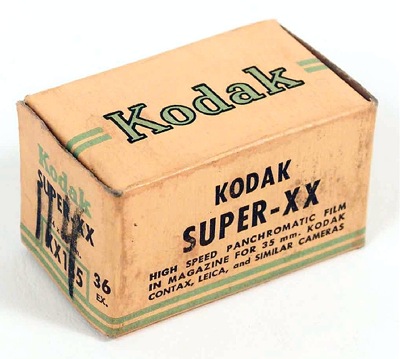 [Our long-term research project, Alternate History: Robert Capa on D-Day, inaugurates the new year with this Guest Post by military historian Charles Herrick, examining newly discovered evidence in support of our radical revision of the Capa D-Day myth.
[Our long-term research project, Alternate History: Robert Capa on D-Day, inaugurates the new year with this Guest Post by military historian Charles Herrick, examining newly discovered evidence in support of our radical revision of the Capa D-Day myth.
In a previous Guest Post, Herrick brought his expertise to bear on film clips by U.S. Coast Guard cinematographer David T. Ruley, made from an upper deck of LCI(L)-94, the ship on which Robert Capa departed from the Easy Red sector of Omaha Beach on D-Day. Those clips included actual scenes of Capa himself about this craft — the only color film of Capa ever made in a combat situation.
Searching further through the USCG film archives, Herrick has now discovered several more Ruley clips made aboard LCI(L)-94 that pertain to Capa’s D-Day narrative. These show the damage to that vessel inflicted by German shelling, to which Capa refers in his several accounts of his experiences during the invasion. Thereby they raise further question regarding the credibility of Capa’s narratives.
Part 1 appears below. Click here for Part 2. — A.D.C.]
•
Damage Report:
Robert Capa and the Shelling of LCI(L)-94
by Charles Herrick
The last medics were just getting out. I climbed aboard. As I reached the deck I felt a shock, and suddenly was all covered with feathers. I thought, “What is this? Is somebody killing chickens?” Then I saw the superstructure had been shot away and that the feathers were the stuffing from the kapok jackets of the men that had been blown up. The skipper was crying. His assistant had been blown up all over him and he was a mess.
Our boat was listing and we slowly pulled away from the beach to try to reach the mother ship before we sank.[1] — Robert Capa, Slightly Out of Focus
That dramatic passage contains Robert Capa’s full description of his departure from the Easy Red sector of Omaha Beach in his 1947 pseudo-biography Slightly Out of Focus. For the most part, it was a word-for-word repetition of the description he gave to Charles Wertenbaker in an interview three days after D-Day, and Capa clearly drew on Wertenbaker’s transcription when he penned his own account. [Wertenbaker’s transcription of his interview with Capa appears in his September 1945 quickie book Invasion! — A.D.C.]
The major difference between the two versions are the details about the ship’s condition: listing and in danger of sinking. It was an odd detail to have left out of his original description, given immediately after D-Day, but the revised imagery of wrack, ruin and bloodshed was so closely in keeping with other D-Day accounts that it raised few questions.

U.S. Coast Guard vessel LCI(L)-94, date, place, and photographer unknown.
And so it was that the public continued to believe this nonsense — and nonsense it proved to be — until the rediscovery of a reel of motion picture film shot aboard LCI(L)-94 by David T. Ruley on D-Day. Those who have been following this project are familiar with the ship and the man. For those who have not, a word or two of background may be helpful.
LCI(L) was a Navy acronym that stood for Landing Craft, Infantry (Large), a type of flat-bottomed amphibious ship which could carry about 200 troops and deliver them directly to the beach during an assault landing. Early on June 6, 1944, LCI(L)-94 had been scheduled to land on Dog Red beach sector; but, on seeing how bad the conditions were on that stretch of beach, it diverted to a slightly more hospitable spot, which it found approximately 2000 yards farther east on the Easy Red beach sector. That happenstance led to LCI(L)-94 becoming Capa’s means of transportation off Omaha Beach.
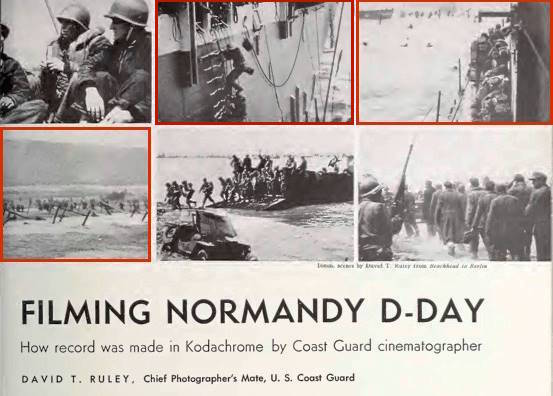
Fig. 8: Cinematographer David T. Ruley, illustrations for first-person account of D-Day experiences, Movie Makers magazine, 6/1/45
US Coast Guard Chief Photographers Mate David Ruley was a crewman aboard LCI(L)-94, one of a half dozen cameramen the Coast Guard had spread across its fleet of LCIs at Omaha Beach. It was Ruley’s motion picture film of Capa aboard LCI(L)-94 which definitively proved that Capa left the beach aboard that ship, and not on LCI(L)-85, as was commonly believed to be the case. And that’s important, because Capa’s LCI(L)-94 was not listing as it left the beach, and was never in danger of sinking. In fact, the only damage it suffered below the waterline was to one of its two propellers.
Capa was a skilled enough teller of tall tales that most of his “exaggerations” had some basis in fact, and so it is that he seems to have lifted the “listing and sinking” details from the ordeal of LCI(L)-85. That ship was badly shot up while attempting to beach at the Fox Green beach sector, and did indeed depart the beach in sinking condition. LCI(L)-94 passed close by the foundering LCI(L)-85 in the Transport Area as both ships returned from the beach. Capa had transferred to the attack transport ship USS Samuel Chase (APA-26), and there he took at least one photo of LCI(L)-85 as it was moored alongside the Chase, transferring off wounded shortly before it sank. It seems Capa appropriated events that he had seen others experience, and wove them into his own story as though they had happened to him.
But if the “listing and sinking” part of Capa’s story wasn’t true, then how much more of his description was also a fabrication? After LCI(L)-94‘s initial beaching and the debarkation of about half the troops, the current had swept the stern of the ship toward a mined obstacle, so the captain, Lt. Gene R. Gislason, had the ship retract off the beach, and then make a second landing about 100 yards farther east. There it unloaded the rest of its troops. Moments later, it was indeed hit by enemy medium-caliber guns, with the loss of two wounded and three killed, according to the ship’s June 1944 Muster Roll. So it is no surprise that there is at least an element of truth to Capa’s description of boarding the ship. But … how much isn’t true?
Perspectives
We have accounts from four crewmen of LCI(L)-94 that shed some light on the question, though some details vary. Motor Machinist Mate 3d Class Charles Jarreau (stationed below decks in the stern steering compartment) stated that they were hit by 47mm guns, losing five men. He was not clear exactly when the ship was hit (his interview was conducted several decades after the fact).[2] Motor Machinist Mate 1st Class Clifford Lewis (stationed below decks in the engine room) recorded in his diary[3] that the ship was retracting from the beach when the captain noticed that they had fouled an LCVP[4] with a line, and started to go back in to assist it when LCI(L)-94 was hit in the pilot house[5] by three shells.
Ruley (who moved between the open bridge and the boat deck during the landings) stated, in a 1946 interview, that the ship was hit three times in rapid succession, twice in the pilot house, killing three and wounding two. [6] Boatswain’s Mate 1st class Mark Graham was stationed on deck, forward at the boarding ramps. In an interview shortly after D-Day[7], he stated that the ship was off the beach and almost clear of the obstacles when they were hit by two shells from a field gun, resulting in three killed and three wounded.
So we have some minor discrepancies concerning the number of casualties, and some larger disagreements concerning the exact moment the ship was hit. Only the ship’s Muster Roll pinned down the time of the hits: 0850 hours. The location of the hits is a matter of speculation. It has been generally accepted that at least one shell hit the pilot house. Lewis claimed three hits there; Ruley claimed two hits there, but didn’t mention where the third landed; and Mark Graham stated that both the pilot house and deck house were each hit once.
While Capa’s own two versions of the event are virtually identical, they do raise some red flags when examined carefully. In both versions, he described just one shell hitting, while all four crewmen noted two or three hits. In his first version (the Wertenbaker interview) he described feeling only a “slight shock” (he omitted the adjective “slight” when he penned Slightly Out of Focus). That is clearly a red flag. He said the shell had not only “blown up” crewmen, but also “shot away” the superstructure. But if he was close enough to such a destructive explosion that he was covered in kapok from the victims, then how is it possible he only felt a “slight shock”? Clearly there are fundamental problems with Capa’s descriptions, and we’ll take a closer look at those later in this article. Let’s leave aside the firsthand accounts for a moment and turn to photographic evidence.
Boat Deck
Once again, Chief Photographer’s Mate Ruley has come through for us. Further exploration of the CriticalPast archives of WWII film footage has turned up yet another 136-second reel of film he took while aboard LCI(L)-94 shortly after D-Day, while the ship was still operating off Omaha Beach. Tucked away in this reel are 45 seconds showing two scenes of combat damage to the ship (starting at timestamp 00:18).
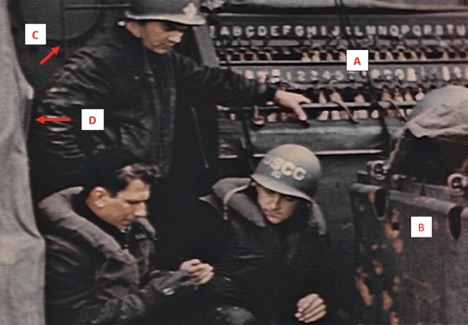
Figure 1. Three crewmen from LCI(L)-94 examine shell fragments plucked from equipment damaged by German fire on D-Day. Still from David T. Ruley film clip. (CriticalPast)
Figure 1 is a still from the first scene in Ruley’s film. One of the three crewmen has just picked up a shell fragment from the damaged area and has passed it to his shipmates for examination. This scene takes place on the boat deck, immediately aft of the pilot house and forward of the number 2 gun mount.
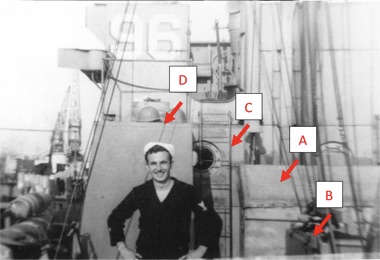
Figure 2. This image (taken aboard LCI(L)-96) provides a better general view of the location seen in Figure 1. (NavSource)
Figure 2 is a picture taken aboard the sister ship LCI(L)-96 and is included to provide a better view of where the previous photo was taken aboard LCI(L)-94. [Original source file: NavSource Online: Amphibious Photo Archive, LCI(L)-96. Click here for original image file.] The letter “A” marks the signal flag locker on both ships (with the flags exposed in Ruley’s clip, but with the locker covered by a canvas top in the second photo). The letter “B” identifies a folding shelf that was attached to the ship’s pyrotechnic locker.
The letter “C” indicates the ladder up to the open bridge, or conn; just beyond the ladder is a porthole in the aft bulkhead of the pilot house. The letter “D” indicates a booby hatch,[8] which is covered by a tarp in Figure 1, but exposed in Figure 2. After entering that booby hatch, a turn to the right would lead to the hatch into the pilot house; a turn to the left would lead to a ladder down to the main deck.
•
The next two photos (Figures 3 and 4) serve to locate the scene in Figure 1 in relation to where Capa’s camera captured the attempts to treat one of the casualties caused by the shelling.
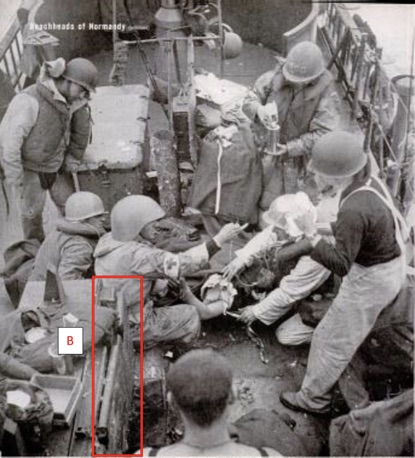
Figure 3. This photo was taken looking in the opposite direction (aft) from figure 1 and shows the location of the damaged shelf (B) relative to where the crew struggled to save the life of Seaman 1st Class Jack DeNunzio. The number 2 gun mount is barely visible at the top of the photo. This photo was taken by Capa and was published in the June 19, 1944 edition of Life. Capa was standing on the open bridge at the top of ladder seen in Figure 1 (C, out of frame to the bottom in this figure).
•
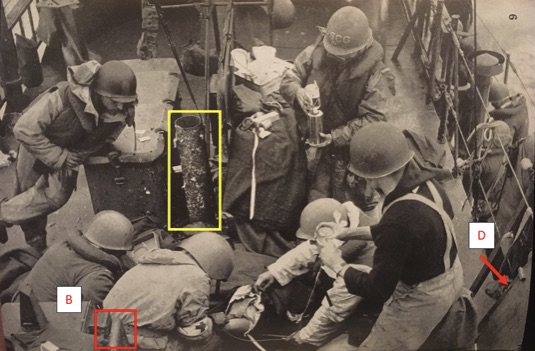
Figure 4. Another Capa photo of the same scene, this one was published in Wertenbaker’s Invasion! In addition to showing the top corner of the shelf (B), it also shows the opened door to the booby hatch (D). Note the vent pipe highlighted by the yellow box. The white flecks are kapok debris as mentioned by Capa. There is very little of this debris beyond the immediate vicinity of the shell’s detonation.
•
The most obvious damage in this new Ruley clip is to the pyrotechnic locker’s folding shelf (Figure 1, “B”), which has suffered holes and dents from shell fragments (in fact, the clip shows one such fragment being taken from the damaged area). The orangeish coloring surrounding most of the holes is the primer coat, which was exposed when the fragmentation blasted off the top layers of paint.
Two features visible in this film clip can help locate the shell’s point of impact. Most obviously, the distorted metal where the fragments struck the shelf indicates the shell detonated on somewhere just to the left of the scene, and the fragmentation then blasted across this area from left to right (from the camera’s perspective in Figure 1), puncturing the shelf and scything down the crewman stationed in the vicinity. Second, a close examination of one of the holes in the shelf (Figure 5, below) reveals gouge marks on the left side of the entry hole. This would indicate that the fragment did not hit directly perpendicular to the face of the shelf, but rather struck it at slightly oblique angle — in this case from an angle slightly forward.
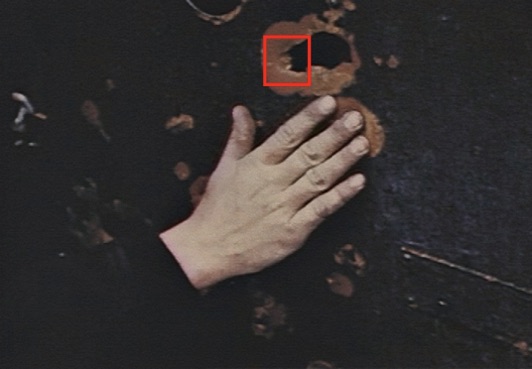
Figure 5. A close examination of this hole reveals gouge marks on the left/forward edge of the puncture. This would indicate the shell fragment struck at an angle to the face of the shelf. Still from David T. Ruley film clip. (CriticalPast)
•
So it would appear that the shell detonated to the left and slightly forward of the damage seen in these images. The only part of the ship in the probable area of impact is the booby hatch. The shell seems to have hit low on the port face of the booby hatch, and either detonated on contact or shortly after penetrating to the interior. Shrapnel then either blew through the thin metal starboard face of the booby hatch (which was only 1/4-inch steel) or blew out through the doorway facing the flag locker. Figure 6 illustrates the probable area of impact on an LCI of the same class. [Original source file: NavSource Online: Amphibious Photo Archive, LCI(L)-87. Click here for original image file.]
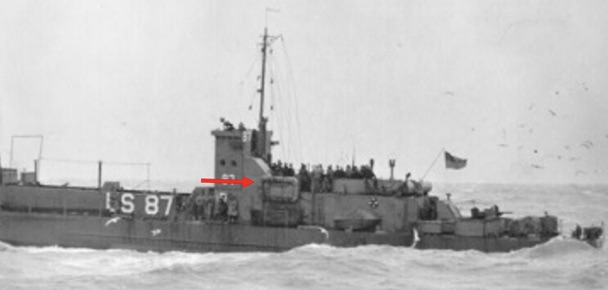
Figure 6. The red arrow indicates the probable area of impact for the shell that caused the damage seen above. (NavSource)
•
We might have confirmation of this in Ruley’s film. Figure 1 shows a canvas tarp draped over the booby hatch. I have not seen any other LCI photo showing a tarp rigged in that fashion, so I suspect it was rigged there to cover shell damage and prevent rain or spray from entering through the holes.
That location is close enough to the deck house proper (just a foot or so above it) that it would be consistent with Graham’s statement that the deck house was hit by one of the shells. And that location on the booby hatch is also close enough to the pilot house — in fact, it is attached to it — that it also could be considered consistent with Lewis’s and Ruley’s statement that the pilot house took multiple hits. Which probably reconciles the three accounts, at least as to location.
Recalling Capa’s “chicken feathers” comments, we can see evidence of kapok debris in Figure 4. The vent pipe in the yellow highlight is coated in white flecks, which are shredded bits of kapok. But that debris field is very limited, and if Capa were to have been covered in “chicken feathers” from that source, he must have been on the boat deck very close to that spot when the shell hit. And he was not. However, in Figure 6 we see another possible source of kapok debris. Slightly to the right of the tip of the arrow is a Carley float, mounted vertically against the ship’s deck house.
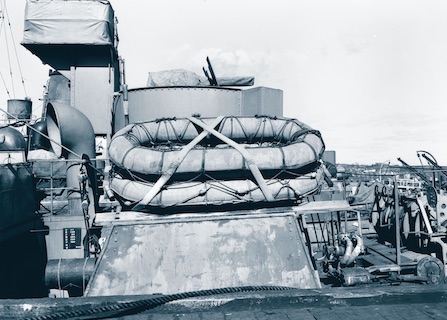
Carley floats. Photographer unknown.
The Carley float was a standard life raft used during the war. Its basic structure was a hollow copper tube fashioned in a rectangular ring. The tube was divided into chambers so that a single leak wouldn’t cause a complete loss of buoyancy, and the tube was then wrapped in cork or kapok, with an outer layer of waterproofed canvas. A shell detonation at this point might have shredded part of that Carley float (depending on whether it detonated on initial contact or after passing through the outer wall of the booby hatch), and if it contained kapok wrapping instead of cork, it could have been the source of the debris that supposedly covered Capa.
The location of the point of impact provides a clue as to the moment the ship was shelled. A hit to that area indicates the ship was generally broadside to the German guns on WN62[9]. This would be consistent with the ship’s orientation while it was still beached, or while it was in the initial stages of retracting.
Graham’s observation at this point seems germane. Recall that he stated the ship was off the beach and almost clear of the obstacles when they were hit. The captain wouldn’t have tried to turn the ship before he was clear of the obstacle belts, so the ship would still have been presenting its port flank to the guns of WN62. Based on these factors, it is safe to conclude Graham was correct; the ship was retracting but still among the obstacles when this projectile hit it.
That accounts for one hit. …
(Part 1 I 2)
•
Notes:
[1] Capa, Robert, Slightly Out of Focus, 2001, Modern Library Edition, p. 148. Originally published by Henry Holt and Company, 1947.
[2] This oral history interview was conducted by Stephen Ambrose and is in the holdings of the National D-Day Museum, New Orleans, LA. The existing transcript of this interview is sadly incomplete. The last page of the interview (page 46) ends in mid-sentence, indicating the interview was longer. In addition, many intervening pages are randomly missing. Only 20 pages of the interview survive.
[3] His diary is among the holdings of the USCG Historians office. An extract of that diary is also contained in Greg H. Williams’s book The US Navy at Normandy: Fleet Organization and Operations in the D-Day Invasion, McFarland & Company, Inc., 2020, p. 251.
[4] Landing Craft, Vehicle, Personnel, also known as a “Higgins boat” after its designer, Andrew Higgins. A small flat-bottomed landing craft with a bow ramp. It could carry about 30 troops, and was one of the principal craft used on D-Day to land troops
[5] The deck house was that part of the superstructure on the level of the main deck. The second deck, above the deck house, was known as the boat deck, and at the forward end of the boat deck was the pilot house. Atop the pilot house sat the open bridge (or conning station).
[6] Ruley, David T., “Filming Normandy D-DAY,” Movie Makers 20:6, June 1945, pp. 213, 228-30.
[7] Conducted by Lt (jg) Coit Hendley, USCG. Hendley was the captain on LCI(L)-85 on D-Day. Following the loss of his ship that day, he was assigned to the staff of the flotilla. During this period, he documented the experiences of the flotilla’s LCIs on Omaha and Utah Beaches.
[8] Used here in its nautical sense, a small companionway secured over a deck opening.
[9] WN62, the abbreviation for Weiderstandnest 62, was the German designation for the fortifications guarding the west side of the Colleville draw, where Exit E-3 led off the beach. Weiderstandnest literally means “pocket of resistance,” and is used to identify a small defensive strongpoint.
•
Text copyright © 2021 by Charles Herrick. All rights reserved.
•
(For an index of links to all posts in this series, click here.)
•
 Charles Herrick joined the U.S. Army in 1970 and graduated from the U.S. Military Academy at West Point in 1974. Commissioned in the Infantry, he earned the Ranger tab and Master Parachutist’s wings. He served in a variety of positions from company grade officer to the Pentagon. He earned the Combat Infantryman’s badge while assigned as the Operations Officer of the 193rd Infantry Brigade in Panama in 1989, and later graduated from the U.S. Army War College.
Charles Herrick joined the U.S. Army in 1970 and graduated from the U.S. Military Academy at West Point in 1974. Commissioned in the Infantry, he earned the Ranger tab and Master Parachutist’s wings. He served in a variety of positions from company grade officer to the Pentagon. He earned the Combat Infantryman’s badge while assigned as the Operations Officer of the 193rd Infantry Brigade in Panama in 1989, and later graduated from the U.S. Army War College.
Since retiring from the Army in 1996, Herrick has continued to work on defense issues as a contractor in East Asia, Latin America, the Balkans, Africa and Central Asia. He holds an MBA from the University of California at Los Angeles. He lives in California with his wife, where he pursues his passion for military history. To contact Charles Herrick, click here.






Leave a Comment